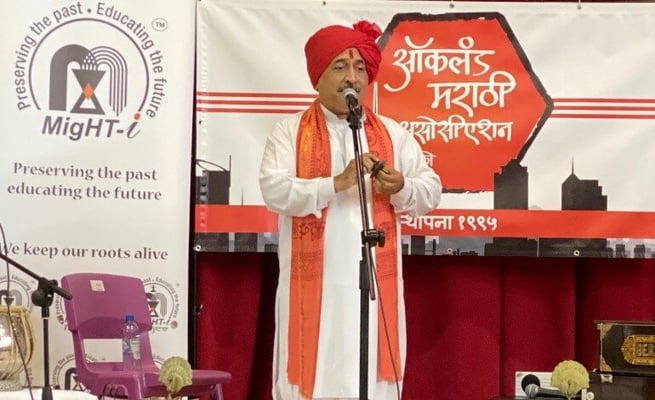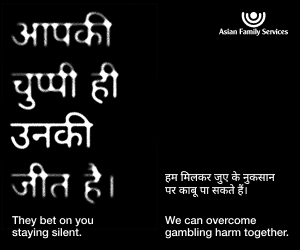Aphalebua’s elevating Kirtans stir Auckland audiences

One of India’s leading exponents of the centuries-old performing art of Kirtan regaled Auckland’s Marathi community with three separate events last week.
Pandit Charudatta Aphale – Aphalebua, or simply ‘Bua’, as his legion of fans and followers in India, particularly Maharashtra, and all over the world fondly call him, left his audiences on cloud nine at the end of each of his events, leaving them asking for more.
The first of these was a Kirtan-style presentation of Swatantryaveer Savarkar, which this writer regrettably missed. According to those who attended it was as informative as it was entertaining. The second was a traditional Kirtan, complete with an accompanying musical ensemble and the third, a private sitting in which Aphalebua musically encapsulated the 140-year rich history of the Marathi sangeet-natak (musical play).
Each of these performances showed what a fine, learned and talented performer Aphalebua is. Kirtan, as it is performed in Maharashtra, needs many skills and talents. “There are ten attributes that are traditionally required for a Kirtankar,” Aphalebua told The Indian Weekender in an interview. A knowledge of scripture, the Sanskrit language, clear diction and delivery in Marathi, a grounding in classical music, the ability to sing and most importantly, the ability to join the dots depending on the kind of audience.

All this and much more goes into the fine performing art of Kirtan. For the benefit of the uninitiated, Aphalebua beautifully explained the nuances and contexts of the art form, making the experience of the performance that much richer. In fact, Aphalebua connects with all kinds of audiences so well, that he travels not just across India but even the world. He came to New Zealand last week after a two-month back-to-back string of Kirtan performances across the United States.
The complex performing art of Kirtan is at least half a millennium old. Its roots can be traced to the spiritual renaissance that flowered across the subcontinent in the medieval age. It took on different regional flavors across undivided India, drawing richly from folk performing art forms and cultural practices.
Therefore, though Kirtan, or performing art similar to it, is common throughout India, every region has differences and the form that it has taken in Maharashtra has its own uniqueness.
Aphalebua is the twelfth-generation exponent of Kirtan, tracing his lineage all the way back to the hallowed Samarth Ramdas, the spiritual guru of the great Maratha king Shivaji Maharaj. Aphalebua’s ancestor was a contemporary of the saint and learned the art from him.
Aphalebua said Kirtan was the main medium that purveyed messages across a wide geography in historical times. Performed in temples and institutions, the exponent would roll devotional music, prayer, commentary, contemporary happenings and much else in an entertaining and informative manner, holding the attention of hundreds if not thousands of people in the audience.
In that sense, Kirtan was classic infotainment centuries before the term was coined and it was THE social media before social media. It is so powerful as a medium and good Kirtankars are so trusted by laypeople, especially in the rural areas, that they are still approached by modern governments to convey messages, Aphalebua said.
For instance, Aphalebua is often approached to include messages of modern scientific farming in his Kirtans. “I learn the topic, discuss the message to be conveyed with experts, then build the creative part of conveying it, relate it to a context and then deliver the message in my Kirtan,” he said. He has included messages on climate change and environment, social ills and even the Indian Government’s Swachch Bharat Abhiyaan, Aphalebua said.
Though an ancient performing art form, it has always had its adherents and a steady following, even in this digital age. He says it is encouraging to see that universities in Maharashtra are running masters’ programmes in Kirtan with substantial enrollments.
“It is not a pursuit that can get anyone a steady income anymore, but people see it as a worthwhile hobby... it is great to see that people who are professional engineers and doctors taking lessons so they can go and perform and pursue their creativity and display their talent,” Aphalebua said.
Like good Kirtankars across the centuries, Aphalebua has honed the art of keeping his content contemporary and fresh. This could be gauged from the numbers of young people attending the concerts last week. Many of these have been in New Zealand most of their lives but could relate very well to the messages and the whole package as it was presented, one young person told The Indian Weekender.
Aphalebua trip was organised under the aegis of the Auckland Marathi Association and the Migrant Heritage Charitable Trust (Might-I).
--
Dev Nadkarni is Editor at Large, The Indian Weekender and secretary of the Mohan Nadkarni Foundation.

One of India’s leading exponents of the centuries-old performing art of Kirtan regaled Auckland’s Marathi community with three separate events last week.
Pandit Charudatta Aphale – Aphalebua, or simply ‘Bua’, as his legion of fans and followers in India, particularly Maharashtra, and all over the...
One of India’s leading exponents of the centuries-old performing art of Kirtan regaled Auckland’s Marathi community with three separate events last week.
Pandit Charudatta Aphale – Aphalebua, or simply ‘Bua’, as his legion of fans and followers in India, particularly Maharashtra, and all over the world fondly call him, left his audiences on cloud nine at the end of each of his events, leaving them asking for more.
The first of these was a Kirtan-style presentation of Swatantryaveer Savarkar, which this writer regrettably missed. According to those who attended it was as informative as it was entertaining. The second was a traditional Kirtan, complete with an accompanying musical ensemble and the third, a private sitting in which Aphalebua musically encapsulated the 140-year rich history of the Marathi sangeet-natak (musical play).
Each of these performances showed what a fine, learned and talented performer Aphalebua is. Kirtan, as it is performed in Maharashtra, needs many skills and talents. “There are ten attributes that are traditionally required for a Kirtankar,” Aphalebua told The Indian Weekender in an interview. A knowledge of scripture, the Sanskrit language, clear diction and delivery in Marathi, a grounding in classical music, the ability to sing and most importantly, the ability to join the dots depending on the kind of audience.

All this and much more goes into the fine performing art of Kirtan. For the benefit of the uninitiated, Aphalebua beautifully explained the nuances and contexts of the art form, making the experience of the performance that much richer. In fact, Aphalebua connects with all kinds of audiences so well, that he travels not just across India but even the world. He came to New Zealand last week after a two-month back-to-back string of Kirtan performances across the United States.
The complex performing art of Kirtan is at least half a millennium old. Its roots can be traced to the spiritual renaissance that flowered across the subcontinent in the medieval age. It took on different regional flavors across undivided India, drawing richly from folk performing art forms and cultural practices.
Therefore, though Kirtan, or performing art similar to it, is common throughout India, every region has differences and the form that it has taken in Maharashtra has its own uniqueness.
Aphalebua is the twelfth-generation exponent of Kirtan, tracing his lineage all the way back to the hallowed Samarth Ramdas, the spiritual guru of the great Maratha king Shivaji Maharaj. Aphalebua’s ancestor was a contemporary of the saint and learned the art from him.
Aphalebua said Kirtan was the main medium that purveyed messages across a wide geography in historical times. Performed in temples and institutions, the exponent would roll devotional music, prayer, commentary, contemporary happenings and much else in an entertaining and informative manner, holding the attention of hundreds if not thousands of people in the audience.
In that sense, Kirtan was classic infotainment centuries before the term was coined and it was THE social media before social media. It is so powerful as a medium and good Kirtankars are so trusted by laypeople, especially in the rural areas, that they are still approached by modern governments to convey messages, Aphalebua said.
For instance, Aphalebua is often approached to include messages of modern scientific farming in his Kirtans. “I learn the topic, discuss the message to be conveyed with experts, then build the creative part of conveying it, relate it to a context and then deliver the message in my Kirtan,” he said. He has included messages on climate change and environment, social ills and even the Indian Government’s Swachch Bharat Abhiyaan, Aphalebua said.
Though an ancient performing art form, it has always had its adherents and a steady following, even in this digital age. He says it is encouraging to see that universities in Maharashtra are running masters’ programmes in Kirtan with substantial enrollments.
“It is not a pursuit that can get anyone a steady income anymore, but people see it as a worthwhile hobby... it is great to see that people who are professional engineers and doctors taking lessons so they can go and perform and pursue their creativity and display their talent,” Aphalebua said.
Like good Kirtankars across the centuries, Aphalebua has honed the art of keeping his content contemporary and fresh. This could be gauged from the numbers of young people attending the concerts last week. Many of these have been in New Zealand most of their lives but could relate very well to the messages and the whole package as it was presented, one young person told The Indian Weekender.
Aphalebua trip was organised under the aegis of the Auckland Marathi Association and the Migrant Heritage Charitable Trust (Might-I).
--
Dev Nadkarni is Editor at Large, The Indian Weekender and secretary of the Mohan Nadkarni Foundation.










Leave a Comment